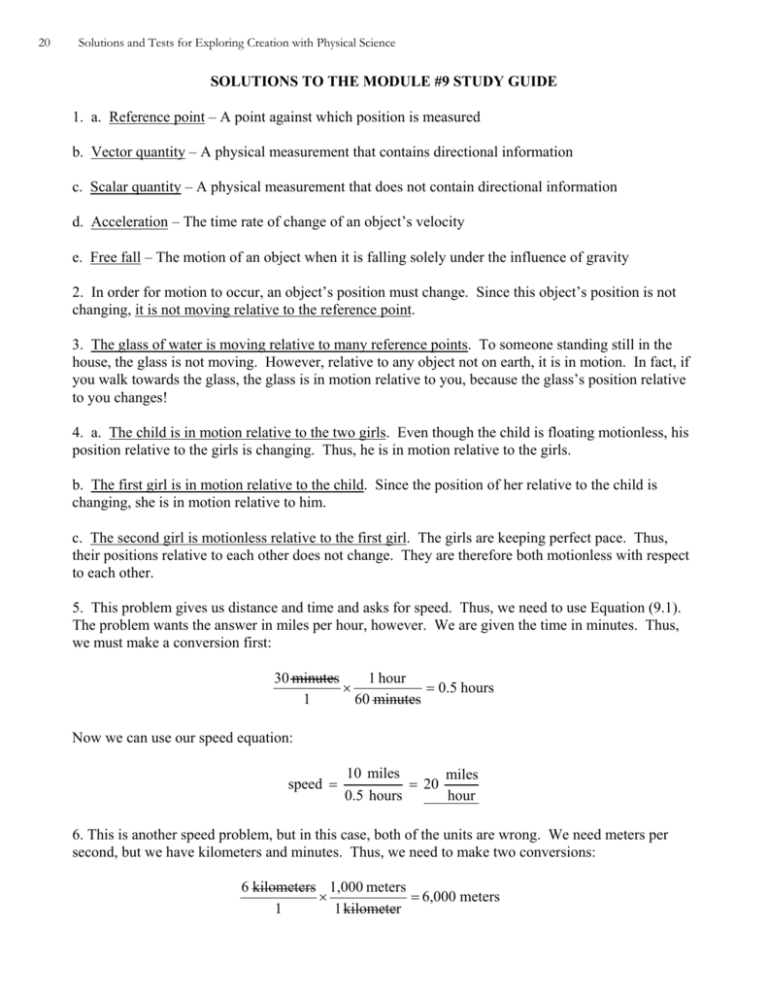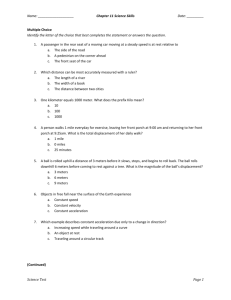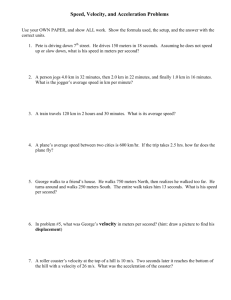SOLUTIONS TO THE MODULE #9 STUDY GUIDE 1. a. Reference
advertisement

20 Solutions and Tests for Exploring Creation with Physical Science SOLUTIONS TO THE MODULE #9 STUDY GUIDE 1. a. Reference point – A point against which position is measured b. Vector quantity – A physical measurement that contains directional information c. Scalar quantity – A physical measurement that does not contain directional information d. Acceleration – The time rate of change of an object’s velocity e. Free fall – The motion of an object when it is falling solely under the influence of gravity 2. In order for motion to occur, an object’s position must change. Since this object’s position is not changing, it is not moving relative to the reference point. 3. The glass of water is moving relative to many reference points. To someone standing still in the house, the glass is not moving. However, relative to any object not on earth, it is in motion. In fact, if you walk towards the glass, the glass is in motion relative to you, because the glass’s position relative to you changes! 4. a. The child is in motion relative to the two girls. Even though the child is floating motionless, his position relative to the girls is changing. Thus, he is in motion relative to the girls. b. The first girl is in motion relative to the child. Since the position of her relative to the child is changing, she is in motion relative to him. c. The second girl is motionless relative to the first girl. The girls are keeping perfect pace. Thus, their positions relative to each other does not change. They are therefore both motionless with respect to each other. 5. This problem gives us distance and time and asks for speed. Thus, we need to use Equation (9.1). The problem wants the answer in miles per hour, however. We are given the time in minutes. Thus, we must make a conversion first: 30 minutes 1 hour × = 0.5 hours 1 60 minutes Now we can use our speed equation: speed = 10 miles miles = 20 hour 0.5 hours 6. This is another speed problem, but in this case, both of the units are wrong. We need meters per second, but we have kilometers and minutes. Thus, we need to make two conversions: 6 kilometers 1,000 meters × = 6,000 meters 1 1 kilometer Study Guide Solutions 45 minutes 60 seconds × = 2,700 seconds 1 1 minute Now we can use those numbers in our speed equation: speed = 6,000 meters meters = 2.2 2,700 seconds second 7. a. This is a scalar quantity since it has no direction. Meters is a distance unit. b. This is a vector quantity, because it has direction in it. The units are distance over time squared, which is acceleration. c. This is a scalar quantity. It has no direction. The units indicate it is speed. d. This is a scalar quantity. It has no direction. Liters is a volume unit, so it is none of these. e. This is a vector quantity, because it has direction in it. The units are distance over time, which is velocity. It is not speed because speed is not a vector quantity. f. This is a scalar quantity. It has no direction. The units indicate it is speed. 8. As the picture shows, the car is behind the truck, but they are both traveling in the same direction. Thus, we get their relative velocity by subtracting their individual speeds: relative velocity = 57 miles per hour - 45 miles per hour = 12 miles per hour Since the car is traveling faster than the truck, it is catching up to the truck. Thus, the relative velocity is 12 miles per hour towards each other. 9. Since the velocity is not changing, the acceleration is zero. The time was just put in there to fool you. Remember, acceleration is the change in velocity. With no change in velocity, there is no acceleration. 10. The initial velocity is 0, and the final velocity is 12 meters per second east. The time is 2 seconds. This is a straightforward application of Equation (9.2). acceleration = acceleration = final velocity − initial velocity time 12 meters meters meters 12 −0 second second = second = 6 meters 2 seconds 2 seconds second 2 Since the speed increased, the acceleration and velocity are in the same direction. Thus, the acceleration is 6 m/sec2 east. 21 22 Solutions and Tests for Exploring Creation with Physical Science 11. This is another application of Equation (9.2), because we are given time (12 minutes), initial velocity (30 miles per hour south) and final velocity (0, because it stops). We can’t use the equation yet, however, because our time units do not agree. We’ll fix that first: 12 minutes 1 hour × = 0.2 hours 1 60 minutes Now that we have all time units in agreement, we can really use the acceleration equation: acceleration = acceleration = final velocity − initial velocity time 0 miles miles miles − 30 −30 hour hour = hour = − 150 miles 0.2 hours 0.2 hours hour 2 The negative sign means the acceleration is in the opposite direction as the velocity. Thus, the acceleration is 150 miles/hour2 north. 12. The physicist is technically correct because for an object to be in free fall, it can only be influenced by gravity. Air resistance is a second influence, and all objects experience air resistance. 13. Even though the physicist is technically correct, the effect of air resistance is so small on heavy objects that it usually can be ignored. 14. Neither will hit first. They both hit together. Remember, gravity accelerates all objects the same. Without air, there is no air resistance, so both objects are in true free fall. As a result, they will fall at exactly the same speed. 15. The rock is in free fall, so we can use Equation (9.3). Since the problem wants the answer in meters, we need to use 9.8 meters per second2 as the acceleration. distance = 1 × (acceleration) × (time) 2 2 distance = 1 meters 1 meters × (9.8 ) × (4.1 seconds)× (4.1 seconds) ) × (4.1 seconds) 2 = × (9.8 2 2 2 second second 2 distance = 1 meters × (9.8 ) × (16.81 second 2 ) = 82.4 meters 2 2 second Study Guide Solutions 16. The rock is in free fall, so we can use Equation (9.3). Since the problem wants the answer in feet, we need to use 32 feet per second2 as the acceleration. distance = 1 × (acceleration) × (time) 2 2 distance = 1 feet 1 feet × (32 ) × (7 seconds) 2 = × (32 ) × (7 seconds) × (7 seconds) 2 2 2 second 2 second distance = 1 feet × (32 ) × (49 second 2 ) = 784 feet 2 2 second 17. Since the object covers less ground in each time interval, it is traveling slower in each time interval. This clearly means that the object is slowing down. When an object is slowing, its acceleration is in the opposite direction of its velocity. Sample Calculations for Experiment 9.3 Time for the ball to fall: 0.79 seconds, 0.60 seconds, 0.70 seconds, 0.82 seconds, 0.65 seconds, 0.89 seconds, 0.83 seconds, 0.69 seconds, 0.59 seconds, 0.92 seconds Average time for the ball to fall: (0.79 seconds + 0.60 seconds + 0.70 seconds + 0.82 seconds + 0.65 seconds + 0.89 seconds + 0.83 seconds + 0.69 seconds + 0.59 seconds + 0.92 seconds) ÷10 = 0.748 seconds Distance the ball fell: distance = 1 × (acceleration) × (time) 2 2 distance = 1 feet 1 feet × (32 ) × (0.748 seconds) 2 = × (32 ) × (0.748 seconds) × (0.748 seconds) 2 2 2 second second 2 distance = 1 feet × (32 ) × (0.559504 second 2 ) = 8.95 feet 2 2 second Measured height of the ceiling: 9.33 feet The height determined by the falling ball is similar to that measured with the tape measure. 23






